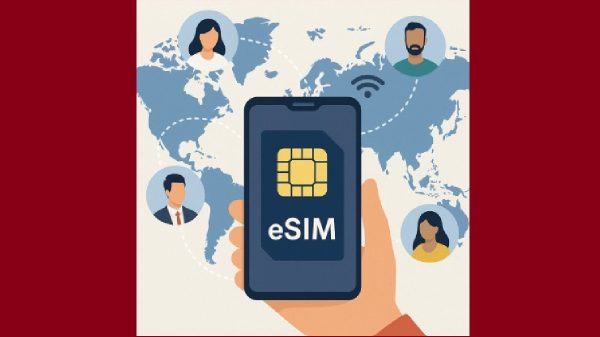The Digital Passport: How eSIM Technology Is Shaping Secure Global Communication in a Connected World
- Update Time : Monday, October 20, 2025

In today’s hyperconnected world, the ability to communicate across borders is as essential as the passport in your pocket. From remote work to international reporting and humanitarian operations, the modern professional depends on fast, reliable, and secure data connections to function in real time. Yet, the traditional tools we’ve used to stay online — plastic SIM cards, patchy Wi-Fi, and expensive roaming plans — are quickly becoming outdated.
Enter the eSIM: a digital innovation quietly revolutionizing how people connect worldwide. This new form of connectivity isn’t just about convenience; it’s reshaping the global communication landscape by offering safer, faster, and more sustainable ways to stay online. In essence, the eSIM is becoming a “digital passport” — one that grants seamless access to networks across continents, without physical limitations or security risks.
What Exactly Is an eSIM?
An eSIM (short for embedded SIM) is a small chip built directly into your smartphone, smartwatch, or tablet. Unlike a traditional SIM card, you don’t have to insert or swap anything. Instead, you can activate a data plan digitally, often within minutes.
Think of it as a virtual key that unlocks mobile networks around the world. You simply buy a plan online, scan a QR code, and — instantly — your device connects to a local carrier wherever you are.
On Holafly’s website, for instance, travelers can browse dozens of country-specific and regional eSIM plans, choosing options that fit both short-term vacations and long-term global assignments. The entire process is paperless, contactless, and immediate.
This might sound like a small technological leap, but the implications go far beyond convenience.
The End of the Plastic SIM Era
For decades, the telecom industry has relied on small pieces of plastic to connect billions of devices. But physical SIM cards are inefficient in a globalized world where people cross borders constantly.
Here’s what makes eSIMs a smarter alternative:
Security First: A New Era of Safe Communication
One of the most underappreciated advantages of eSIM technology is data security. In an age when identity theft, SIM card fraud, and data interception are real threats, the eSIM offers a more secure foundation.
Traditional SIM cards can be cloned, stolen, or swapped out without the owner’s knowledge — a method commonly used in “SIM swap” attacks to hijack personal accounts or banking details. Since an eSIM is embedded directly into your device, it can’t be physically removed or replaced.
Moreover, eSIMs make it easier for professionals — especially those working in sensitive fields such as journalism, finance, or government — to control their mobile identity while traveling. They can instantly switch networks or delete profiles if necessary, maintaining operational privacy.
For humanitarian workers and remote journalists operating in unpredictable environments, this flexibility can literally be a lifeline.
The Practical Edge for Global Citizens
eSIM technology also reflects a shift toward greater digital independence. Global travelers, remote workers, and expats no longer have to rely on unstable hotel Wi-Fi or overpriced roaming plans. Instead, they can purchase data from international providers before even leaving home.
Here are a few real-world benefits:
1. Instant Connectivity Anywhere
No need to queue at airport kiosks or hunt for local SIM cards. You can land in Tokyo, London, or Nairobi and connect to a local network within seconds.
2. Cost Transparency
Most eSIM plans come with fixed data packages, meaning no surprise charges when you return home.
3. Dual Functionality
You can keep your U.S. or Canadian number active for important messages while using a local eSIM plan for data abroad — perfect for business travelers who need to stay reachable.
4. Multi-Country Coverage
Some eSIMs offer regional plans that cover entire continents, like Europe or Asia. It’s connectivity that moves with you.
In other words, eSIMs don’t just simplify travel — they empower it.
Canada’s Growing eSIM Adoption
In Canada, eSIM usage is on the rise, driven by both major telecom providers and independent travel data platforms. As remote work becomes more common and international travel rebounds, Canadians are seeking reliable, cost-effective ways to stay online overseas.
Many tech-forward travelers are discovering global options through platforms like Holafly’s website, which offers data plans for destinations from Mexico to Morocco. These flexible solutions are especially appealing for digital nomads and entrepreneurs — people who value autonomy and need uninterrupted access to digital tools across time zones.
What’s more, eSIM compatibility is expanding rapidly. Newer smartphones from Apple, Google, and Samsung all include eSIM capability as standard, and carriers in more than 100 countries now support it.
The Economic Ripple Effect
Beyond individual convenience, the rise of eSIMs has far-reaching economic implications.
Telecom giants are being forced to rethink roaming models, as consumers opt for more flexible, transparent alternatives. At the same time, smaller providers and startups are entering the market, offering competitive pricing and global coverage.
For developing regions, eSIMs could help bridge the digital divide by enabling easier access to international networks — especially where traditional telecom infrastructure is limited.
There’s also a sustainability angle: moving away from billions of physical SIM cards reduces plastic production, shipping emissions, and electronic waste. The GSMA (Global System for Mobile Communications Association) estimates that over 4.5 billion SIM cards are manufactured annually. If eSIM adoption continues at its current pace, that number could drop by half within the next decade.
Beyond Travel: eSIMs and the Future of Digital Identity
As technology evolves, eSIMs could play a central role in the next stage of digital identity management. Imagine a world where your smartphone — through a secure, encrypted eSIM — serves not only as your communication hub but also as a verified ID for accessing global services.
This convergence is already starting. In the European Union, for example, policymakers are exploring how mobile credentials and eSIM-based authentication can simplify cross-border services like healthcare, digital banking, and e-government.
For travelers, this means one thing: the boundary between digital life and physical mobility is disappearing. The same technology that connects you to Wi-Fi in Paris might soon grant you access to digital healthcare records or tax filings across countries.
Challenges Ahead
Of course, eSIM adoption isn’t without hurdles. Some regions still lack full support for eSIM provisioning, and not all devices — especially budget models — include the feature. Privacy advocates also warn that increased digitization of mobile identity requires stricter international regulations to prevent misuse or surveillance.
Still, the momentum is undeniable. As more manufacturers, governments, and telecoms invest in digital infrastructure, eSIM technology will become as common as Wi-Fi itself.
Conclusion: The Future Is Seamlessly Connected
The eSIM is more than a gadget feature — it’s a glimpse into the future of global mobility. By merging communication, security, and sustainability, it’s setting a new standard for how we interact with the world around us.
Whether you’re a journalist covering international affairs, a student studying abroad, or a business owner expanding into global markets, eSIM technology offers a smarter, safer way to stay online without borders.
The next time you prepare for an international trip or remote assignment, remember: your passport may grant you entry, but your digital passport — powered by eSIM technology — keeps you connected.

















